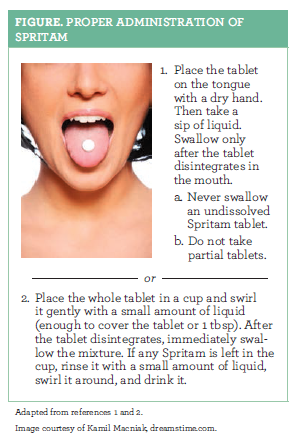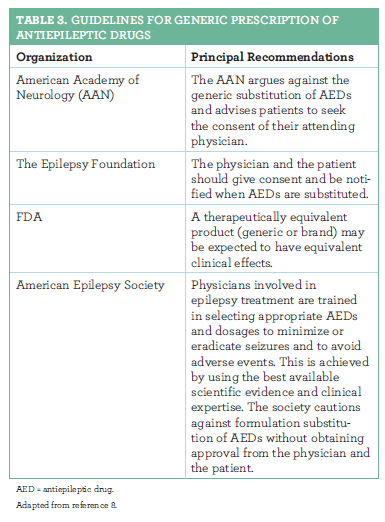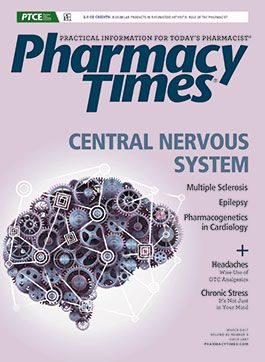Publication
Article
Pharmacy Times
Epilepsy: What You and Your Patients Need to Know
Author(s):
The year 2016 was big for neurology, particularly in the realm of epilepsy.
The year 2016 was big for neurology, particularly in the realm of epilepsy. The FDA approved several medications and formulations for treating seizures. This article focuses on the first FDA-approved medication manufactured using 3-dimensional (3D) printing and highlights 3 common questions about epilepsy to address when counseling patients.
New Approvals
The FDA has approved the following medications for treating epilepsy: Fycompa (perampanel oral suspension), Briviact (brivaracetam), Spritam (levetiracetam), and Carnexiv (carbamazepine injection) (Table 11-5).
TABLE 1: ANTIEPILEPTICS APPROVED BY THE FDA IN 2015 AND 2016
Fycompa (perampanel)
Briviact (brivaracetam)
Spritam (levetiracetam)
Carnexiv (carbamazepine)
Schedule
III
V
N/A
N/A
Approval date
May 2016
February 2016
August 2015
October 2016
Formulation
- Oral suspension (2016)
- Tablets (2012)
- Tablets
- Oral solution
- Injection for IV use
Tablets for oral suspension
Injection
Boxed warning
Yes: serious psychiatric and behavioral reactions
N/A
N/A
Yes: serious dermatologic reactions, aplastic anemia, and agranulocytosis
Indications
- Partial-onset seizures
(≥12 years)
- Primary generalized tonic-clonic seizures
(≥12 years)
- Partial-onset seizures (≥16 years)
- Partial-onset seizures (≥4 years and >20 kg)
- Myoclonic seizures (≥12 years)
- Primary generalized tonic-clonic seizures (≥6 years)
- Replacement therapy when oral administration. of carbamazepine is temporarily not an option:
- Partial seizures
- Generalized tonic-clonic seizures
- Mixed seizure patterns
Contraindications
None
Hypersensitivity to brivaracetam
None
- Bone marrow depression
- Hypersensitivity to carbamazepine and TCAs
- Concomitant use of boceprevir, nefazodone, delavirdine, or other NNRTIs
- Use of MAOIs within the past 14 days
Precautions
- Suicidal behavior/ideation
- Neurologic effects
- Falls
- Withdrawal seizures
- Suicidal behavior/ideation
- Neurologic effects
- Psychiatric effects
- Hypersensitivity
- Withdrawal seizures
- Suicidal behavior/ideation
- Behavioral changes
- Somnolence and fatigue
- Withdrawal seizures
- Suicidal behavior/ideation
- Embryo fetal toxicity
- Abrupt discontinuation
- Hyponatremia
- Hepatic toxicity/hepatic porphyria
- DRESS
Adverse effects
- Dizziness
- Somnolence
- Fatigue
- Irritability
- Falls
- Nausea
- Somnolence
- Sedation
- Dizziness
- Fatigue
- Nausea
- Vomiting
Adults:
- Somnolence
- Asthenia
- Dizziness
Children:
- Fatigue
- Aggression
- Irritability
- Dizziness
- Somnolence
- Blurred vision
- Diplopia
- Headache
- Infusion-related reactions
- Anemia
Drug interactions
- Contraceptives
- CYP450 inducers
- Strong CYP3A inducers (other than AEDs)
- Rifampin
- Carbamazepine
- Phenytoin
- Levetiracetam
No known drug interactions through CYP450
- CYP3A4 inhibitors and inducers
- Medications metabolized by CYP1A2, 2B6, 2C9/19, and 3A4
Pregnancy
Based on animal data, may cause fetal harm
Category C: no human data
Category C: no human data; based on animal data, may cause fetal harm
Risk for embryo fetal toxicity
Lactation
No human data
No human data
Excreted in human milk
Excreted in human milk
Recommended dose
Maintenance:
Partial-onset seizures: 8-12 mg at bedtime
Primary generalized tonic-clonic seizures: 8 mg at bedtime
Dose range:
25-100 mg twice daily
Dose range:
250-1500 mg twice a day (depends on weight and indication)
Dose:
70% of the total daily dose of oral carbamazepine divided in 4 infusions separated by 6 hours (infused over 30 minutes)
(Not recommended for periods longer than 7 days)
Counseling points
- Shake suspension well before each use
- Use correct measuring device
- Discard unused suspension 90 days after bottle was first opened
- Do not stop AED suddenly
- Take with or without food.
- Swallow tablets whole with a liquid
- Do not chew or crush tablets
- Use correct measuring device (solution)
- Do not stop AED suddenly
- Place tablet on tongue, let it disintegrate, and then swallow
OR
- Place tablet in a cup and swirl gently with a small amount of liquid; then drink mixture (Figure )
-Do not stop AED suddenly
Administered in a health care setting
AED = antiepileptic drug; DRESS = drug reaction with eosinophilia and systemic symptoms; MAOI = monoamine oxidase inhibitor; NNRTI = nonnucleoside reverse transcriptase inhibitor; TCA = tricyclic antidepressant.​Adapted from references 1-5.
Spritam
Spritam, a new formulation of levetiracetam, is the first FDA-approved medication manufactured by 3D printing. It was approved as an adjunctive treatment for partial-onset seizures in patients with epilepsy (4 years and older weighing more than 20 kg), myoclonic seizures in patients with juvenile myoclonic epilepsy (12 years and older), and primary generalized tonic-clonic seizures in patients with idiopathic generalized epilepsy (6 years and older.)
Through 3D printing, Spritam is created by binding layers of powdered medication with an aqueous fluid rather than via compression. This technology permits a porous design, allowing the tablets to disintegrate rapidly (mean time: 11 seconds) and masking the taste of levetiracetam. The tablets are available in 250, 500, 750, and 1000 mg1,2 and disintegrate in the mouth when taken with a sip of liquid.1
Spritam is marketed as being easy to administer to patients who have difficulty swallowing tablets or capsules, who do not like the taste or texture of a liquid formulation, or who have difficulty measuring doses accurately.1 When counseling patients on how to take Spritam, 2 methods of administration are available1,2 (Figure1,2).

Frequently Asked Questions
If I have epilepsy, may I still drive my vehicle?
The state will not issue a driver's license to individuals with epilepsy unless they meet cert-in requirements. Each state’s laws are different, but the common requirement is being seizure free for a specified period of time. A physician’s evaluation for the ability to drive safely may be needed.
Another requirement is periodic medical updates after licensing. This may be required for a specified period of time or for as long as an individual holds a license. For detailed information on state driving laws regarding epilepsy, refer to the State Driving Laws Database on the Epilepsy Foundation’s website (epilepsy.com/driving-laws).6
TABLE 2: POTENTIAL PROBLEMS REPORTED WITH GENERIC SUBSTITUTION OF ANTIEPILEPTIC DRUGS

AED = antiepileptic drug.Adapted from reference 8.
Can I switch to the generic version of my antiepileptic medication?
Various guidelines recommend that patients whose epilepsy is under control avoid switching from a brand name to a generic medication, a generic to a brand name, or a generic to another generic. Substituting antiepileptic medications is an issue, especially in high-risk groups. Individuals considered to be at high risk include very old and very young patients, pregnant women, individuals with multiple conditions, individuals taking several medications, patients taking medications with a narrow therapeutic index, patients requiring individualized dosing, and patients taking medications that exhibit serious drug—drug interactions.
A recent systematic review evaluated 68 articles to identify the potential issues associated with substitution. The issues were associated with bioequivalence, drug therapy failure, adverse events, and an increase in seizure frequency7 (Table 28). The guidelines on substitution differ among organizations7 (Table 38).

If I have epilepsy, may I participate in sports and/or an exercise program?
According to the CDC, regular exercise may help maintain seizure control. Partaking in an exercise program or in sports may improve patients’ mental, physical, and emotional health.8 The decision to participate in certain activities should be individualized, however. Although most sports/activities are safe for those with epilepsy, certain ones may require accommodations or should be avoided. The question to ask is: what would happen if the individual has a seizure while playing the sport or taking part in an activity?9
The following precautions can help individuals with epilepsy stay safe while being active9:
- Use a buddy system.
- Make sure someone present is aware of the possibility of a seizure. This individual should know basic lifesaving techniques if watersports are involved.
- Always wear appropriate protective gear for the sport or activity (eg, a life vest for water-related activities).
- If you tire easily, do not overdo it. Listen to your body, and exercise in small amounts.
- Always wear a medical alert bracelet or necklace.
- Speak to a health care provider about the risks involved.
Individuals with uncontrolled seizures should avoid participating in activities that require full concentration (eg, skydiving, scuba diving, rock/mountain climbing). Loss of consciousness during these dangerous activities may result in injury or death.9
Anyssa Garza received her doctor of pharmacy degree from the University of Texas at Austin before becoming the director of pharmacy for a Central Texas Department of Aging and Disability facility. She now serves as the vice president of content and patient education programs at RxWiki. In this role, she provides patients with medication information, with the goal of contributing to the quality of patient care and improving quality of life and health outcomes. Her work focuses on educating patients and providing them with resources for navigating health care issues and the complex health system. She also serves as an adjunct assistant professor at the University of Texas at Austin College of Pharmacy.
More resources pertaining to epilepsy can be found on Pharmacy Times' sister site, NeurologyLive. The Clinical Focus condition page serves as a home for the latest clinical news, articles, videos, and newly released data from the field's most attended conferences.
References
- Spritam (levetiracetam) tablets for oral suspension. Spritam website. spritam.com/#/hcp. Accessed November 26th, 2016.
- Spritam [prescribing Information]. East Windsor, NJ: Aprecia Pharmaceuticals Company; 2016.
- Fycompa [prescribing information]. Woodcliff Lake, NJ: Eisai Inc; 2016.
- Briviact [prescribing information]. Smyrna, GA: UCB, Inc; 2016.
- Carnexiv [prescribing information]. Deerfield, IL: Lundbeck; 2016.
- State Driving Laws Database. Epilepsy Foundation website. epilepsy.com/driving-laws. Accessed November 30, 2016.
- Atif M, Azeem M, Sarwar MR. Potential problems and recommendations regarding substitution of generic antiepileptic drugs: a systematic review of literature. Springerplus. 2016;5:182. doi: 10.1186/s40064-016-1824-2.
- Epilepsy: frequently asked questions. CDC website. cdc.gov/epilepsy/basics/faq.htm. Accessed November 28, 2016.
- Safety with exercise and sports. Epilepsy Foundation website. epilepsy.com/get-help/staying-safe/safety-exercise-and-sports. Accessed November 30, 2016.







